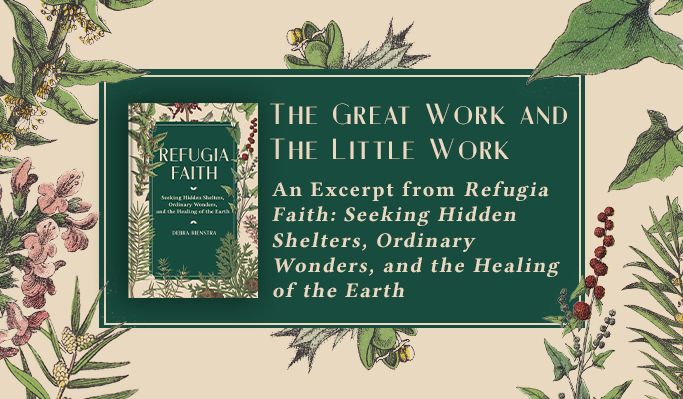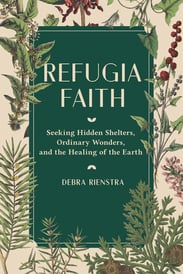
I am like a desert owl, like an owl among the ruins.
—PSALM 102:6 NIV
When Mount Saint Helens erupted in May of 1980, it lost 1,300 feet of elevation and gained a new mile-and-a-half-wide crater. The debris and ashfall from the volcanic blast devastated the mountain and its surroundings for miles, crushing, burning, killing, and coating everything in hot ash. Everyone assumed life could return to this apocalyptic death zone only very slowly, maybe over several human lifetimes.
Instead, forty years later, the mountainsides are covered with lush grasses, prairie lupines, alders. Critters scamper, streams flow. It will take a few hundred more years for the vegetation to return to something like old-growth forest. But still. Why did life come back with such vigor, and so quickly? As Kathleen Dean Moore explains in her book Great Tide Rising, “What the scientists know now, but didn’t understand then, is that when the mountain blasted ash and rock across the landscape, the devastation passed over some small places hidden in the lee of rocks and trees. Here, a bed of moss and deer fern under a rotting log. There, under a boulder, a patch of pearly everlasting and the tunnel to a vole’s musty nest.” These little pockets of safety are called refugia. They are tiny coverts where plants and creatures hide from destruction, hidden shelters where life persists and out of which new life emerges.1
We are living in a time of crisis eruption. Our failures of vision and restraint have propelled us into ecological danger on a scale never before seen in human history. The future is uncertain; it always is. We do not know exactly what’s coming. But the earth teaches that extreme disturbance can be survived and can even bring renewal—and one way this happens is through refugia.
This book asks the question, How can people of faith become people of refugia? How can we find and create refugia, not only in the biomes of the earth, but simultaneously in our human cultural systems and in our spirits? We will need a tough, new kind of resilience and a greater capacity for cooperation. Is it possible to work together, applying all our love and creativity to this task as never before?
As a person of faith, I believe in the divine mystery, a loving God who is always calling us through the wonders and suffering of this world to transform our ways, a God who draws us relentlessly toward the divine purpose of flourishing for the whole earth and all its creatures. At least I try to believe that. In recent years, it has been difficult to keep a steady grip on this vision. The worldwide disruption we experienced during the Covid-19 pandemic made our vulnerability obvious and urgent, exacerbating our already inflamed anxiety. On any given day during those long months, I would ricochet from anxiety about the virus, to anger about the president’s latest insulting tweet, to an aching sorrow over abusive church leaders or racist judicial systems or tar sands extraction—whatever nightmare heaved to the surface of the day’s news. In the next minute, I might rejoice in a downy woodpecker at the bird feeder.
Even now that it seems we have found our way through the worst of those awful days, the churning feelings linger. We still live precariously on fault lines. They send fissures through our neighborhoods, our churches and religious organizations, our national and local politics, our families. The anxieties may have subsided, but only from acute to chronic. In the United States, we still navigate seemingly separate realities constructed from our information sources, convictions, and identities and bundled together by our fears. All of this detracts from our ability to work on our generation’s greatest challenge: the climate crisis. In fact, our world seems to be in crisis convergence, and it all feels overwhelmingly tangled and impossible. Even when millions set their shoulders to the task of healing, the powers of destruction and evil loom large.
Where is God? I’ve wondered that more than ever in these past few years. All those promises in the Scriptures about God bringing justice and renewing the earth: Why do they remain unfulfilled? Centuries ago, the prophet Isaiah cried out to God, “Tear open the heavens and come down!” (Isa 64:1), and these words echo in our minds. As for my fellow Christians: how often they disappoint. We are distracted or indifferent. We drag our feet and justify our complicities in evils small and great. We are swayed by lies and seduced by power. We are supposed to be people of hope, people who witness to God’s good purposes. But are we? As I have struggled in these past few years to process growing alarm about the climate crisis as well as eruptions of ugliness in American politics and the American church, I look to those threads of Scripture where the people of God cry out, “How long, O Lord?” (Ps 13:1; 79:5; etc.). And I wonder why, after all these millennia, we’re still pleading.
Yet I know from the broad sweep of Scriptures, from history, and from my own experience that God is always at work somehow and that God loves to work in small, humble, hidden places. The more I think about it, the more I realize that God loves refugia. The refugia model calls us to look for the seed of life where we are, concentrate on protecting and nurturing a few good things, let what is good and beautiful grow and connect and spread. Trust God’s work. As the etymology of the term implies, refugia are places of refuge. They are places to find shelter—but only for a time. More importantly, refugia are places to begin, places where the tender and harrowing work of reconstruction and renewal takes root. In human terms, refugia operate as microcountercultures where we endure, yes, but also where we prepare for new ways of living and growing. They are places of trust, because in biological as well as cultural refugia, we have to surrender our illusions of full control. In fact, sometimes what seems impossible is exactly the place to begin, because divine powers are at work far beyond our ability to perceive.
Refugia, then, are neither bunkers nor beachheads. In times of crisis, religious people are sometimes tempted to remove ourselves from “society” out of fear and disgust, hoping to wall off a space safe from pollutants where we can protect some fantasia of holiness and purity.2 The opposite temptation is a kind of triumphalism, in which we seek strategic dominance, infiltrating and controlling every aspect of society for God, as if God needs our human systems of dominance to squash out the competition. People have always mustered persuasive arguments for these impulses—to hide or to conquer. But as I hope to demonstrate in the pages that follow, God’s preferred way seems less like walls or combat boots and more like a tray of seedlings. God seems to appreciate the humble, permeable, surprising potentials of refugia. I think of refugia faith, then, as a sort of alternative posture, a posture not of retreat or conquest but of humble discernment and nurture. Refugia faith continually asks, Where are refugia happening, and how can we help? Where do refugia need to happen, and how can we create them?
World religions scholar Mary Evelyn Tucker observes that, since the last decades of the twentieth century, the world’s great religions have been entering their “ecological phase.”3 The question, she writes, is whether religious people and organizations will entrench in old ways or, alternatively, dig deep into their traditions, cherish the treasures awaiting there, and transform those resources for survival in a new era. Many wise and prophetic people have begun this work of digging, cherishing, and transforming. Thanks to their example, I’ve come to believe that, in these times of crisis convergence, the Christian faith offers treasures both ancient and new, yet we have only begun to draw on those treasures.
Christianity is not the only source of wisdom for these times, of course. Pope Francis himself makes this point in his 2015 encyclical, Laudato si’: “If we are truly concerned to develop an ecology capable of remedying the damage we have done, no branch of the sciences and no form of wisdom can be left out, and that includes religion and the language particular to it.”4 We will need to draw on every stream of wisdom available. For this reason, it’s been heartening to see increased interfaith dialogue as well as greater attention to marginalized voices, such as those of Indigenous peoples. While I attend admiringly to these developments and continue to learn from them, Christianity is the stream of wisdom I know best. So as I seek my own role in responding to our crisis convergence, I begin in the only place I can: with my own faith tradition.
As I have rummaged through the Christian tradition, wondering how its richness might help me manage in these confusing days, I have felt missing pieces falling into place. Even after a lifetime of Christian practice, graduate-level biblical and theological study, connection to numerous Christian institutions, and decades of writing about faith, I now realize that until recently I had not thought very deeply about moths or thunderstorms or prairie wildflowers or the crucial role of fungi in a forest ecosystem. For too long, “nature” was something I sang about in church for a verse or two or mined for a handy poetic metaphor. “Creation theology” seemed simple and obvious and not nearly as interesting as, say, theological aesthetics. However, now that our planet is crying out—groaning in loud and obvious ways—I realize that every aspect of theological reflection and faith practice is incomplete if it remains up in the head, bereft of deep engagement with our material life on this earth. I have felt driven to a reassessment of my own faith, sometimes by recovering old treasures, sometimes by devising or seeking new ones. Without this process, I realize, my faith will be left insufficient for the day.
In these pages, then, I try to discern what this time requires and demonstrate what it feels like to wake up to an urgent call. I reflect on my own process of reeducation, my efforts to seek the wisdom of theologians and philosophers, farmers and nature writers, scientists and activists, and especially people leading from the margins, all toward answering this question: How must we adapt Christian spirituality and practice in order to become healers of this damaged earth? How can I join with like-minded people in this work? The urgency of the climate crisis offers us this gift: the opportunity to reassess. In these pages I describe my tentative, initial attempts to adopt a refugia faith.
I offer no one-size-fits-all program for refugia faith, only an invitation to use our shared creativity and common longing to discover what refugia faith might mean. The chapter titles suggest that refugia faith may entail fundamental and perhaps uncomfortable shifts, from consuming to healing, for example. These are, of course, attempts to name matters on the way to understanding them. My hope is that others might find here inspiration, questions to ponder, consolation and challenge.
This is an excerpt from the introduction of Refugia Faith: Seeking Hidden Shelters, Ordinary Wonders, and the Healing of the Earth.



